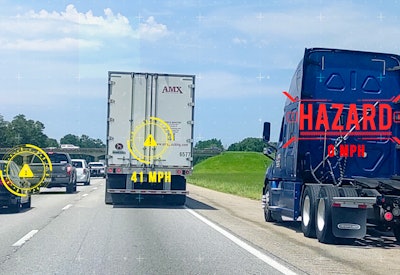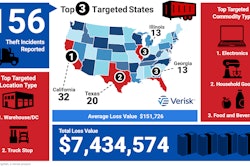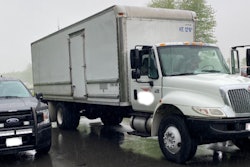
The comment period for the joint notice of proposed rulemaking (NPRM) proposing to mandate automatic emergency braking (AEB) systems on heavy trucks by the National Highway Traffic Safety Administration and Federal Motor Carrier Safety Administration closed last week, with plenty of input from owner-operators, truck drivers and associations around trucking. The rule also proposes to mandate electronic stability control (ESC) systems for truck classes not currently required to be outfitted with ESC (10,000-26,000 lbs.), then proposing an extended timetable for those trucks to be outfitted with AEB as well.
As previously detailed, Class 8 truck owners and operators provided a number of cautionary tales of AEBs getting hard on the brakes when it wasn't necessary. Several larger associations noted they'd heard similar input from their members. Several trucking stakeholder groups of carriers and other truck owners, while supportive of the idea of having a driver-assist technology to alert drivers of a problem on the road ahead, felt the proposal from the agencies still needed work to recognize the assist nature of current AEB technology. As one association put it, though regulation does play a role in safety, "in today’s trucking industry, that endgame result is still the professional truck driver” at the controls.
Other groups took their criticism a step further, contending FMCSA and NHTSA failed to follow a directive from Congress in the 2021 infrastructure legislation regarding AEBs.
The Owner-Operator Independent Drivers Association said the rulemaking as proposed doesn't ensure AEB systems “will meet necessary safety standards before the technology requirement becomes effective.”
OOIDA echoed owner-operators who raised issues of false activations of AEB systems, arguing that the NPRM “mandates AEB systems without sufficiently addressing false activations, properly consulting with professional truck drivers, or completing ongoing research programs.”
The group said it believes the proposal tries to meet Congressional deadlines “at the expense of satisfying the requirements for driver consultation and safety,” adding that FMCSA and NHTSA “seem poised to ignore the operational experience and concerns of those who make their living behind the wheel. Instead, DOT should listen to truckers and take all the time necessary to address the shortcomings of these systems.”
CDL Drivers Unlimited strongly objected to the proposal on somewhat similar grounds, with concerns that FMCSA and NHTSA had not followed the 2021 infrastructure legislation's direction that the agencies review AEB systems and address any deficiencies, likewise consult with truck drivers regarding their experiences with AEBs. Congress also called for a DOT study of equipping under-26,000-lb. trucks with AEBs -- those units have not previously been required to have electronic stability control systems. The study was directed to include “an assessment of the feasibility, benefits, and costs associated with installing” the systems.
With publication of the NPRM, NHTSA and FMCSA declared the notice itself to represent such review and study, summarizing a great deal of past research around AEBs. "The analysis accompanying this NPRM fulfills this requirement," the agencies stated.
CDLDU, in its comments, said the “instructions are straightforward and specific as to how you were to conduct your actions and investigate this subject matter and then come to an understanding [of] how this eventual rulemaking would [ensure] a safer and more thorough consideration. Why weren’t the instructions followed?”
The group asked to see “the research, studies, surveys, and current wide range testing that was conducted. We know that many of our member drivers will be put at greater safety risk and an undue financial burden to comply with this faulty proposed rule.”
OOIDA elaborated in their own comments that truck owners and operators as a general rule are not opposed to technology that might help "improve their safety and the safety of other motorists. But until the agencies can offer assurances this rulemaking can meet its desired safety objectives, they should not set forth any mandate.”
Regarding reports of false activations specifically, OOIDA said the proposal doesn’t outline testing protocols and performance standards that will ease drivers’ worries. The testing procedures outlined in the proposal -- the steel trench plate test and the pass through test -- won’t ensure safe performance as currently designed, as they do not properly solve false activation problems, OOIDA said. “The NPRM seeks to effectively replace professional drivers possessing years of experience and millions of accident-free safe driving records with equipment admittedly lacking thorough testing,” OOIDA added. “It is inconceivable the government would require professional drivers to acquiesce control of CMVs to a technology the agencies openly admit may or may not be able to accurately detect legitimate threats.”
Ultimately, OOIDA called on DOT to “overhaul the NPRM in the interests of all motorists, and in particular the professional drivers who travel our highways.”
[Related: AEBs ready for prime time? 'False positive' reports cast doubt]
Like OOIDA and CDLDU, the National Association of Small Trucking Companies raised concern over the alleged safety benefits of AEBs. “We know from member companies’ driver experience with AEBs that these features put the lives and safety of truck drivers and the people in vehicles near them in jeopardy every day,” NASTC said. “AEBs sometimes suddenly slam on a truck’s brakes. This catches the truck driver by surprise. The suddenness of the device’s action causes near-misses and may require evasive action on the professional driver’s part. At present and for the foreseeable future, AEBs present more of a threat to road safety than a solution.”
As part of its comments, NASTC included commentary from members relaying their experiences with the technology. The majority reported negative experiences.
Striking a similar chord that in comments filed by the Commercial Vehicle Safety Alliance, detailed at the top of the story at this link, both the Truckload Carriers Association and the American Trucking Associations recognized that the design of AEBs is intended to mitigate crashes, not prevent them, “and that driver trust remains a major barrier to maximizing the potential of not only AEB but Advanced Driver Assistance Systems (ADAS) more broadly," ATA said. "A well-trained and attentive driver is the safest thing you can have on a truck, and technology that supports the driver rather than hinders them or erodes their trust will achieve the best safety outcomes.”
ATA’s primary concerns with the proposal are within the medium-duty (Classes 3-6) sector, which Congress required the agencies to study before proposing a rule. ATA noted that while it strongly supports AEB in all vehicles, “the reality of AEB in medium-duty Class 3-6 vehicles is that the technology is not as widely available as NHTSA and FMCSA believe, and that development would take longer and be more expensive than proposed, particularly among vehicles with hydraulic brakes.”
ATA also cautioned FMCSA and NHTSA to “not discount driver concerns over false activations, adverse weather performance, or unintended consequences. NHTSA and FMCSA should use the proposed rule as an opportunity to address these concerns and improve usability for drivers.” The group said the agencies should consider how treating AEB like a crash prevention technology “could potentially increase false activations, create unintended consequences, and exacerbate the problem of driver trust.”
“The intent of ADAS and AEB are that the driver should always remain in control and that the technology helps the driver attend and respond to potential crashes,” ATA said. “The DOT’s proposed approach to mandating the technology should reflect this fact.”
TCA took that thought further, with greater emphasis on the importance of the driver. “Mitigating or lessening the severity of the accident is commendable," TCA said, "but it should be noted that AEB and its corresponding technologies are not entirely accident prevention measures that NHTSA and FMCSA seek to supply. In today’s trucking industry, that endgame result is still the professional truck driver.”
Despite reports of false positives from drivers across the industry, both TCA and ATA said the associations and their members "still support technology that would lead to fewer road accidents in an effort to prevent crashes.”
The National Tank Truck Carriers group representing the tank truck industry said it supports the NPRM, noting that many of its members have already added AEBs to their trucks “and have seen positive safety benefits with their implementation.”
NTTC noted that it “does not have any concerns about AEB false activations assuming sensors are properly installed. False positive alerts, triggered by guardrails and construction barrels as examples, can result from poor sensor alignment.”
The National Safety Council voiced support for the proposal, even taking it a step further by recommending additional provisions to strengthen AEB requirements. Among the recommendations are to require pedestrian and bicyclist AEB systems in heavy vehicles, and to require AEB performance standards in low lighting conditions. NSC noted a 2022 study by the Insurance Institute for Highway Safety (IIHS) that indicated that AEB systems using camera sensors performed poorly at night.
“This NPRM proposes testing AEB performance in dry daylight conditions on straight roadways,” NSC said. “Because heavy trucks operate in a variety of lighting conditions, NHTSA and FMCSA should set performance standards and test in low light.”
Like the NSC, the Advocates for Highway and Auto Safety are in favor of an AEB mandate on heavy trucks, but noted there are some technical issues that the agencies should address. Those include AEBs for vulnerable road users like pedestrians and cyclists, darkness testing, testing requirements for electronic stability control systems for Class 3-6 heavy vehicles and more.
[Related: How AEBs helped mitigate some loss of life in terrorist truck strike]










